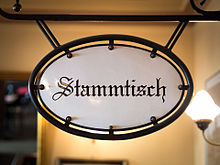|
Stammtisch
   A Stammtisch (German for "regulars' table",[1] [ˈʃtamtɪʃ]) is an informal group meeting held on a regular basis, and also the usually large, often round table around which the group meets. A Stammtisch is not a structured meeting, but rather a friendly get-together. Traditionally, the meeting table is marked with a somewhat elaborate sign reserving it for regulars. Historically, a Stammtisch was an all-male affair that might involve socialising, card playing (such as Skat or Schafkopf), and often political or philosophical discussions. The words Stammtischpolitik (Stammtisch politics) and Stammtischniveau (Stammtisch level) describe the simplified nature of Stammtisch discussions, and have an established metaphorical usage in describing simplified political and social discussions beyond the Stammtisch itself.[2] HistoryPastEspecially in rural areas and smaller villages, being part of the Stammtisch was often related to a certain social status. In the second half of the 19th century a Stammtisch typically consisted of local dignitaries such as the mayor, doctor, pharmacist, teacher, forester or wealthy farmers.[citation needed] Inviting a stranger to take a seat at the Stammtisch was a sign of extraordinary appreciation. This was similarly the case with types of regulars’ tables in cafes consisting of writers and artists. This culture is still to be found in the Iberian area (Spain, Portugal, Latin America and Brazil) in the form of Tertulias. In Great Britain and Ireland many pubs fulfilled this function by offering separate back rooms (in case there was no doorkeeper). In the United States a group of regulars (such as in the T.V. series Cheers) would be a close equivalent. Today's meaningToday a Stammtisch is not connected to a specific social status. It is now all about community, intimacy and shared interests, such as traditional card games. Socio-cultural aspectsIn the countrysideHere the Stammtisch is still one of the main places for social interaction. Especially the lack of varied leisure time facilities and local media leads to the Stammtisch being an important center to socialise: Local relationships are being managed and news exchanged. A Stammtisch does not just take place in the evenings but also after the Sunday Mass, called "Frühschoppen" (English: "Morning Half-Pint"). Sometimes a Stammtisch is the organizer of local events such as fairs. In the cityIn urban areas, especially in the late 1990s, different kinds of Stammtisch groups have been established acting like a loose, informal club of people sharing similar interests on a specific topic. They are meant for socialising, exchange of experience and networking (e.g. Stammtisch for parents). Networking organisations such as clubs for marketers or entrepreneurs often call their regular events, which are also open to non members, a Stammtisch. Historical examples
Stammtisch in literature
Stammtisch in German TV
Stammtisch in EnglishAlthough not used popularly, the word itself is an idiomatic expression which does not have an English equivalent. The nearest would be 'regulars' table'. Thus the word has already two established plural versions in English:
See also
References
External links
|